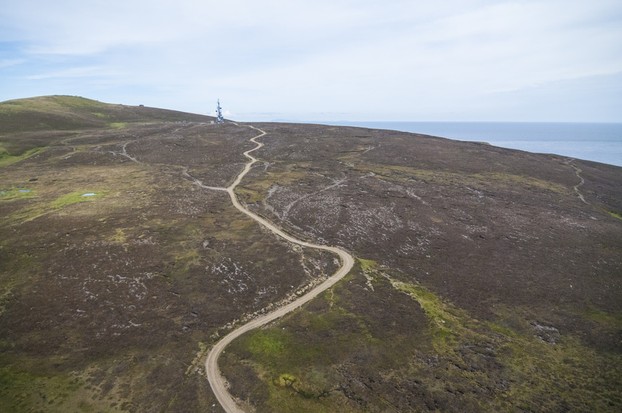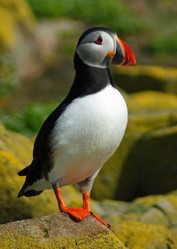Fair Isle means in Norn the Isle of Sheep, which were the mainstay of what was once an isle with a population of four hundred, now down to thirty seven people who each do a variety of jobs to keep the island viable. Sheep farming is important, though the fleeces now are worth little, and the islanders try to be self-sufficient in vegetables. There was a wind turbine that generated electricity, but it was damaged by a lightning strike and has had to be repaired, though there have been delays in the process and thus expensive diesel oil has had to be used, but even then the power goes off at nights and people have to use oil lamps or candles. At that latitude the winter nights are long and the locals have to fill in their time doing crafts.
Like Foula the children have to go and board at school at the age of eleven, which puts stresses on family life, and sometimes it is difficult for the children to return for family visits, as the island is sometimes during the winter season cut off for several weeks. So stocking up on supplies is vital strategy. Access is by a plane or a ferry, which brings in the heavy goods. The National Trust, which owns the island, tries to maintain the community makes housing affordable, but maintaining properties in such a damp climate is difficult.
If there is one product that defines Fair Isle it is hand-knitted woollens [hats, jumpers,gloves, scarfs and socks] each of which has a pattern. The industry developed in the seventeenth century and provided a good source of income supplying polar expeditions at times. The islanders still spend the Winter nights knitting and sell their products on to visitors from cruise ships, often wealthy Chinese or Americans.
The future of Britain's loneliest inhabited isle is probably secure, as its people want to maintain their community, but they are trying to attract extra community members, for they know that if there were the loss of three families population decline might be fatal to community survival. A group have formulated an action plan to attract new people.
One woman is trying to industrialise the process of knitting Fair Isle woollens by introducing commercial knitting machines, but she is meeting resistance on the grounds that the distinct character of the product is that it is hand-knitted. It seems likely that the hand-knitted tradition will survive, but a cheaper , industrially-knitted version might come onto the market, possibly for sale through the on-line-shop that she hopes to open.











 Pilgrimage. A review17 days ago
Pilgrimage. A review17 days ago
 Leo the Fourteenthon 05/09/2025
Leo the Fourteenthon 05/09/2025
 The Melsonby Hoardon 03/25/2025
The Melsonby Hoardon 03/25/2025



Comments
No, the only festival that I know is Up Hellly Ah, the mid winter fire festival. St Patrick's day is not celebrated.
On another point there is good soil in parts of Orkney.
Thank you for your comment below in answer to my previous, same-day observation and question.
It must be difficult dealing with poor soil when one already must deal with stormy air, stormy land, stormy water.
Importing foodstuffs must be expensive what with the storm-challenged transport.
Would the northern isles-ers (or any remote islands-ers) have signature drinks and foods that especially work wonders during holidays -- would they celebrate St. Patrick's Day? -- and during stormy-air, stormy-land, stormy-water days?
The northern isles have poor soil, so they must import some foodstuffs.
Thank you for your comment below in answer to my previous observation and question.
Stormy air, stormy land, stormy waters cause me to consider how self-sufficient the remote isles-ers can be.
Is it possible for remote isles-ers to drink juices and milks because of their own fruit-growing and livestock-raising and to eat meats and vegetables because of their own livestock-raising and vegetable-growing?
Is it possible for remote isles-ers to make desserts -- ice cream and pastries -- and special alcoholic and non-alcoholic drinks with the grains and the grasses that they have there?
Yes. The British Isles are a stormy place.
Your introduction advises us that "All of these isles are difficult of access and battered by stormy seas which cut them off for some of the year."
Is the storminess of the seas reflected in storminess of the air such as to preclude helicopter and plane travel?
St Kilda is the most common and therefore best understood usage.
You reference, under your first subheading Journeying Northwards, the name Hirta for St. Kilda.
Online sources show different etymologies: Celtic Ei hirt ("dangerous, deathlike"); Gaelic Ì Àrd ("high island"); Irish ler ("west"); Norse Hirðö ("herd island"), hirt ("shepherd") and hirtir ("stags"); and Scots Gaelic hlar-Tir ("westland").
Which would be favored on your side of the (Atlantic) pond by those such as you who would know?
Yes, Derdriu, those are the islets in the St Kilda archipelago where hunting took place.
The bottle was tossed into the sea at Village Bay. The locals knew the tides and currents well and were certain that it would wash up on the beach on the Isle of Lewis.
I am sorry, but I have never heard of the trilogy of which you write.
frankbeswick, Thank you for the photos, practicalities and products.
Are the islands where the people of St. Kilda grazed sheep and hunted seabirds Boreray, Dûn and Soay?
Do we know where on St. Kilda and where on Lewis a bottle respectively could be tossed and washed up? It must come down to precise knowledge of well-kept time and well-behaved water and wind.
In another but related direction, I remember reading about Machair in conjunction with Peter May's Lewis trilogy. What was the series like, and what were the rationale behind, and the reaction to, it being set in a real-filmed community with a made-up name instead of one of the Outer Hebrides' real place names?